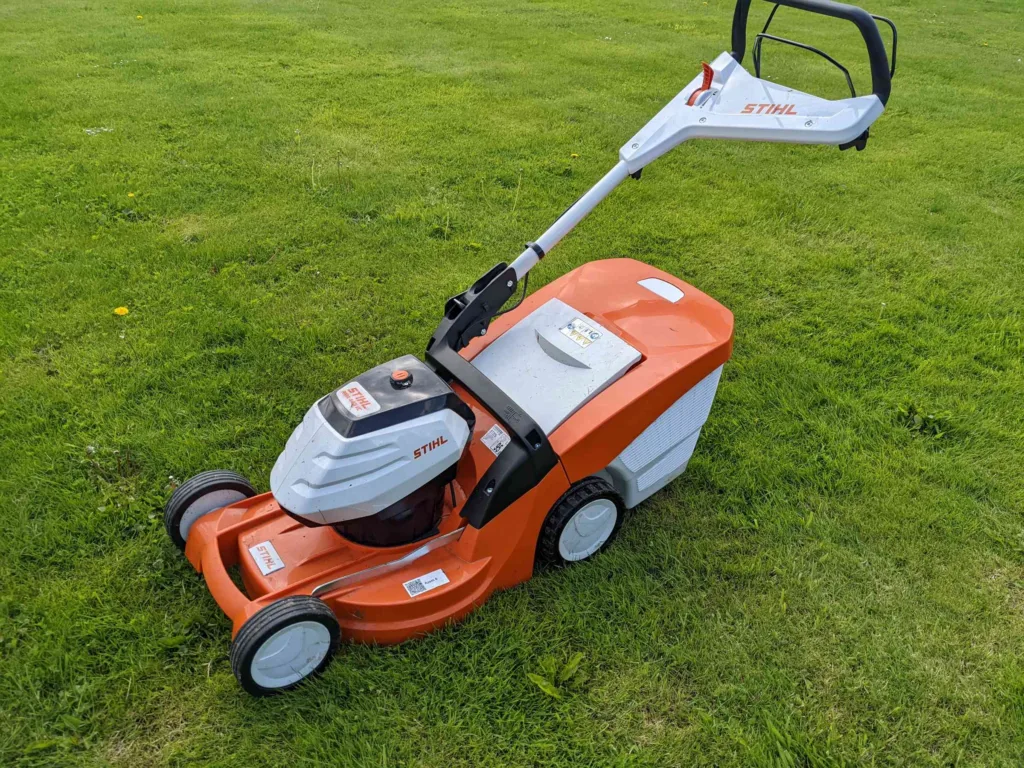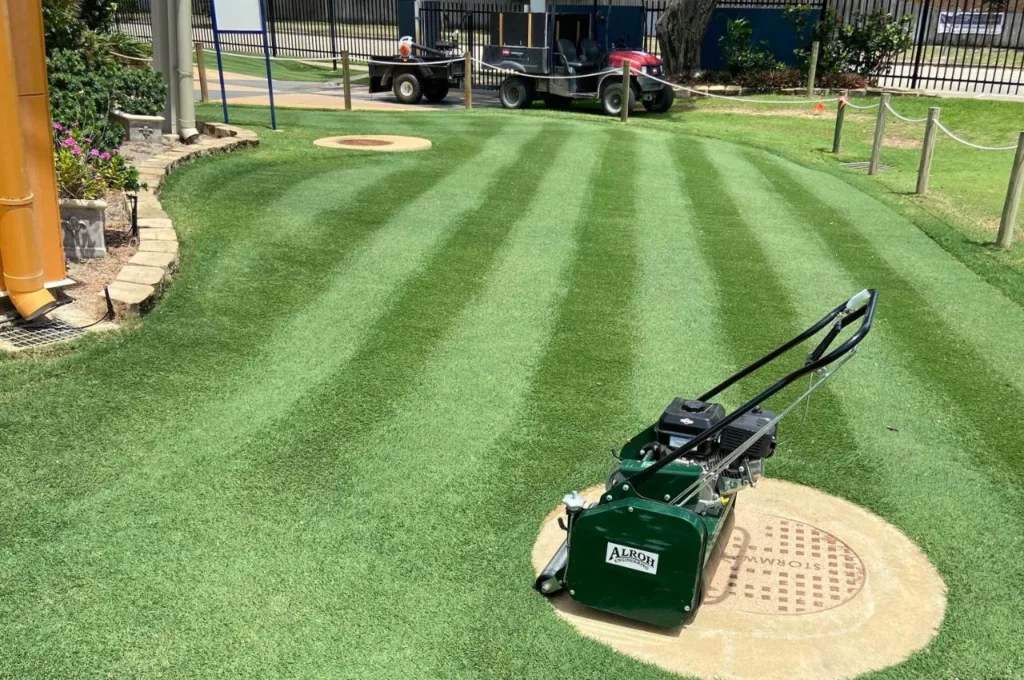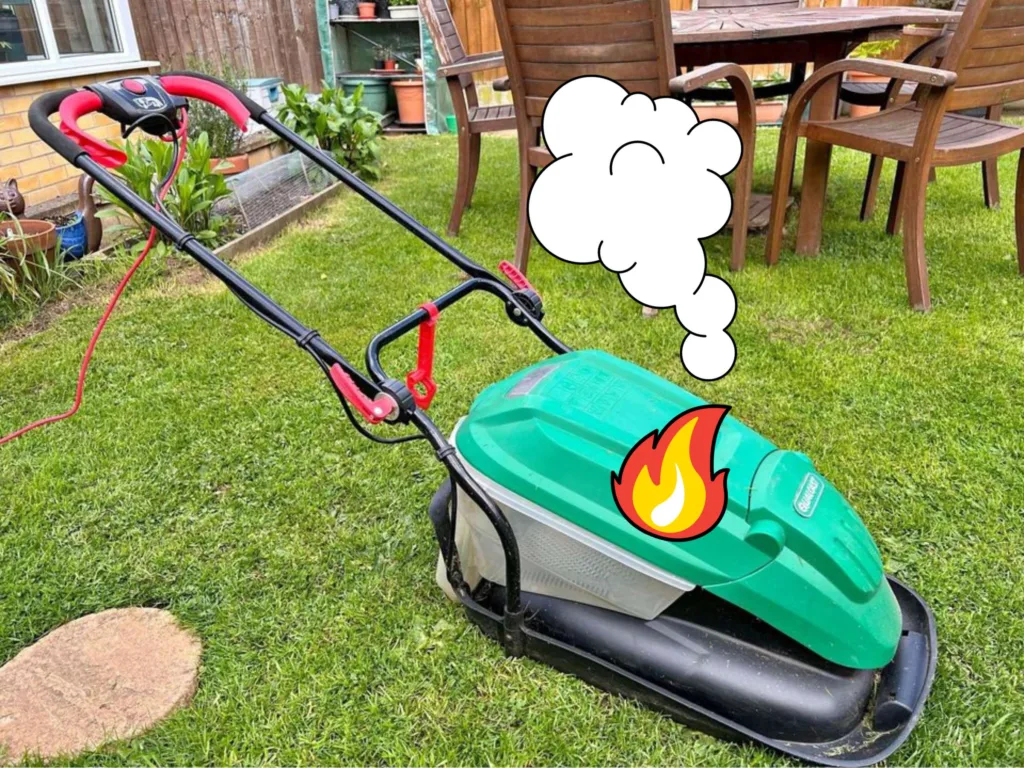Trying to choose between a self-propelled mower and a push mower for your lawn?
In this guide, we’ve compared self propelled mowers with push mowers, discussing their features, benefits, setbacks, and main differences. By the end, you should be able to confidently choose the mower type that suits you best.
✅Key Takeaways:
The main difference between self-propelled mowers and push mowers is that self-propelled mowers have a self-propulsion feature that enables the mower to move forward independently, while push lawnmowers need to be pushed manually.
You may prefer a self-propelled lawn mower if you have a bigger lawn (250m² or larger) and you have the extra budget to spend on a mower that will help you to mow faster and more efficiently.
If your lawn is smaller, it might not be worth paying the extra cost of a self-propelled mower that can’t be practically utilized for its intended purpose.
Table of Contents
🔍 Are Self-Propelled Or Push Mowers Best? Short Answer
When comparing self-propelled vs push mowers, there is no definite best choice for everyone. The best mower for you depends on your situation.
Self-propelled mowers are best for anyone with a larger budget who wants to efficiently and quickly mow a larger lawn without the physical pushing effort, while conventional push mowers are best for anyone with a smaller lawn with a lower upfront spend who’s happy to push the mower manually.
🤷♂️ What Are Self-Propelled Lawn Mowers?
Self-propelled mowers are like conventional push mowers, but with one important difference: they use a self-propulsion function that moves the mower forward with a powered drive system.
A self-propelled lawn mower transfers power from its engine to the wheels, prompting the mower to move forward when you squeeze the self-propulsion bar against the handle.
Most self-propelled mowers are petrol-powered, although there’s an emerging market of environmentally-friendlier battery-powered mower models with self-propulsion.
✅ Pros of Self-Propelled Lawn Mowers
Self-propelled mowers take a lot of hard work off your hands (literally). You don’t have to physically push the mower – you can simply walk behind it and steer.
This makes these mowers ideal for mowing larger lawns or lawns with a lot of hills, since you can use far less physical effort to mow, including when mowing inclines.
You can often get the job done faster because the speed of the self-propulsion is brisk and efficient. Most self-propelled mowers operate at a fast walking pace.
There are several different choices when it comes to engine power, power type (i.e. petrol vs battery), and self-propulsion speed, so you should find a mower that suits you well.
These mowers are easier to manoeuvre around trees, planters, and other obstacles on your lawn because you only have to worry about steering, rather than putting your back into pushing the handles.
❌ Cons of Self-Propelled Lawn Mowers
Most self-propelled mowers for domestic use have only a single speed setting, which might not match up with your walking speed.
These mowers cost around 20% more than push mowers because of their self-propulsion feature, so they’re not ideal for anyone with a smaller budget.
Due to the extra weight of the self-drive system, a self-propelled lawn mower is heavier and more difficult to get in and out of storage.
Most self-propelled mowers are only designed for forward movement, so you’ll still need to manually pull the mower backwards.

💪 What Are Push Lawn Mowers?
Conventional push mowers are mowers that don’t have a self-propulsion drive system.
A push mower is your bog-standard lawn mower, without the extra perks of being self-driven. The operator is in full control over the mower, and, as the name suggests, the mower only moves when the handle is pushed.
There are a variety of push mowers available today, including petrol mowers, electric push mowers, battery-powered mowers, and manual mowers (which are the ultimate push mowers because your push power drives the blades as well as moving the mower forward).
✅ Pros of Push Lawn Mowers
Push mowers are available in a bigger variety of models and power types. You’re not limited to only petrol and cordless models – you can also consider corded electric mowers and manual mowers.
You can control how quickly or slowly you mow your lawn with a push mower. You don’t have to keep up with the mower’s self-propulsion speed.
It’s easier to manoeuvre and store a push mower because it’s lighter and less bulky due to the lack of additional self-drive features.
Push mowers are more affordable than self-propelled models, and there are some very affordable options for smaller lawns (costing less than £100).
This mower type is often more practical to use on a smaller lawn and is better suited to lawns with lots of tight spots and corners, where you may need to turn or mow back and forth in the same small area.
❌ Cons of Push Lawn Mowers
A push mower requires more effort because you have to push the mower forward yourself.
You’ll find it more difficult to use a push mower on a large or hilly lawn, and on long, thick grass, because of the extra pushing effort required.
It’ll take you longer to mow a large lawn with a push mower because you’ll likely walk more slowly than you would with a self-propelled model.
It’s not recommended to use a standard push mower on a very big garden for this reason. It’ll take too long, you’ll tire yourself out – it’s just not worth it!

🧐 Self-Propelled Vs Push Mowers: Main Differences
Let’s take a look at the main differences between self-propelled and push mowers.
💰 Cost
There’s a significant difference in cost between a self-propelled mower and a standard push mower.
Push mowers cost between £80 and £250 on average. The price of a push mower depends on the power type, the mower size, and any additional features it might have (such as a rear roller or a mulching kit).
Self-propelled mowers are usually more expensive, costing 200-£450 on average. There are a couple of reasons why these mowers are more expensive:
You can only buy petrol and cordless mowers with self-propulsion, and these mower types are more expensive than manual and corded electric mowers.
The self-propulsion feature is a costly add-on that contributes to the overall upfront cost of the mower.
Verdict: Push mowers are better for smaller budgets, while self-propelled mowers are the more expensive mower type.
😤 Mowing Effort
Mowing range is another obvious factor that differentiates self-propelled and push mower models.
A self-propelled mower is easier to use because it has a self-drive function that means you don’t have to physically push the mower. However, getting the mower in and out of storage is more difficult because of the extra weight of this feature.
A conventional push mower requires more effort to use because you have to physically push the mower forward on your lawn. However, push mowers tend to be lighter and more manoeuvrable than self-propelled mowers, so they’re easier to get in and out of storage and are better suited to smaller lawns with tight spaces.
Verdict: Self-propelled mower models are easier to mow with compared to push mowers.

📐 Size & Design
You can buy self-propelled mowers and conventional push mowers in several sizes and designs. However, there’s a difference in the offerings available for each mower type.
Self-propelled mowers tend to be petrol mowers. There are also some self-propelled cordless mowers available today. You can find a variety of mower designs and add-ons, including self-propelled mulching mowers, and self-propelled mowers with rear rollers.
Self-propelled lawnmowers are usually wider and bulkier to cover more ground with each pass of your lawn. The average cutting width for this mower type is 38-56cm.
Push mowers are available in a bigger range of mower types. As well as petrol and cordless mowers, you can buy corded electric push mowers, manual push mowers, and hover mowers. As with self-propelled mower models, you can buy push lawn mowers with all the add-ons you might want or need.
Conventional non-self-propelled mowers are available in smaller sizes, with smaller cutting widths of 30-40cm.
Verdict: Both mower types have plenty of designs and sizes to choose from, but push mowers give you more choice (especially if you’re looking for a smaller, more affordable mower).
🏍 Performance Power
There’s also a difference in performance power when comparing self-propelled vs push lawnmowers.
A self-propelled mower needs to have a more powerful engine or motor. Not only does the mower need enough power to spin the blades fast enough to cleanly cut grass, but it also needs to drive the self-propulsion system. Most self-propelled lawnmowers have an engine power of 123-145 cc or higher.
Power is less important in a push mower because only enough power is required to spin the blades. The mower’s power range depends on the power type. A comparable non-self-propelled petrol lawnmower will usually have a smaller engine of 125-127 cc.
Verdict: Electric mowers are powerful, but petrol mowers are even more powerful and have better performance capabilities.

📑 Which Mower Is Best For Which Lawn Type, Size, & Use Points?
Below, we’ve shared a few different use cases for self-propelled and push mowers, to help you decide which mower type is best for what situation.
🏔 Hills & Uneven Ground: Self-Propelled Lawn Mowers
A self-propelled mower doesn’t need to be physically pushed, so it’s the best option for hills and uneven terrain. This mower type won’t increase your physical exertion when mowing up inclines, and you’re less likely to lose control of the mower.
🤏 Small Lawns With Tight Spots: Push Lawn Mowers
Push mowers are smaller, lighter, and easier to manoeuvre, so they’re the more practical choice for lawns with obstacles and tight spots. A self-propelled mower is likely to be unnecessary in this scenario.
📏 Long, Thick Grass: Self-Propelled Mowers
Self-propelled mowers are best for lawns with long, thick grass because they don’t require any physical pushing effort. You won’t struggle to get the mower over thick patches of grass because the self-propulsion function will handle it all.
🟩 Large Lawns: Self-Propelled Lawn Mowers
Again, self-propelled mowers are better for large lawns because they’re more powerful and have a self-drive function, so you don’t have to tire yourself out pushing the mower for an extended period of time. An efficient self-propelling mower with a wide cutting width will help you to mow large spaces quickly and with fewer laps.
🛡 Commercial Purposes: Both Mower Types
Both self-propelled and push mowers are good for commercial purposes – the best mower type depends on the job. For domestic lawn mowing, either mower type is fine. For mowing large areas of land, self-propelling mowers are best.
🤨 Should You Choose A Self-Propelled Mower Or A Push Mower?
When deciding between a self-propelled mower and a push mower, ask yourself the following questions:
How big is my lawn? If you have a medium-to-large lawn, a self-propelled mower is the more practical option. If your lawn is small, with lots of tight spaces, a push mower is best.
How much control do I like to have over my mowing? If you like to mow at a leisurely pace, a push mower is better than a self-propelled model.
What’s my budget? If you have less than £200 to spend, you’ll be limited to push mowers. If your budget can stretch to £250-£400 and beyond, you can also consider self-propelled mowers.
Which mower type do I most like the sound of? If you prefer the idea of a self-propelled lawnmower and you have the extra budget to spend upfront, then go for it. If you prefer to spend less on a mower that requires more effort to use, then a push mower is best.
Ultimately, we can’t tell you for certain which mower to pick – it depends on your circumstances and personal preferences. One mower type might be the more practical option for you, or you might simply prefer to use one or the other.
Just remember to be wise with how you spend your money. Read customer reviews before you click “buy” to make sure you’re getting the best value for your investment. You might also want to check out our review of the best self-propelled mowers and all our other mower reviews, which you can find on our blog.
💬 Self-Propelled Vs Push Mower FAQ
Should I get a push or self-propelled lawn mower?
Get a push mower if your lawn is smaller with more tight spots, you want to spend less money upfront, and you don’t mind the physical effort of pushing a mower. Get a self-propelled lawn mower if you can stretch your budget to a more expensive mower, you have a larger lawn or need to mow hilly terrain, and you want to put less effort into your mowing.
Do self-propelled mowers cut better?
Self-propelled mowers don’t technically cut better because they use the same blades as conventional push mowers. However, the mowers have a consistent forward movement, enabling them to cut more evenly and precisely. This can result in a more uniform and attractive lawn appearance.
Is a self-propelled electric mower worth it?
A self-propelled electric mower is worth it as long as you make sure to invest in a mower that’s powerful enough to drive the mower’s self-propulsion and spin the blades without killing the battery or hindering the mower’s performance. Make sure to read customer reviews and choose a mower with a powerful battery.
What’s the difference between hand-propelled and self-propelled lawn mowers?
“Hand-propelled” is just another way of saying “push”, so the difference between hand-propelled and self-propelled lawn mowers is that hand-propelled mowers only move forward when they’re pushed, while self-propelled mowers move forward by the power of a motorized self-drive system.
